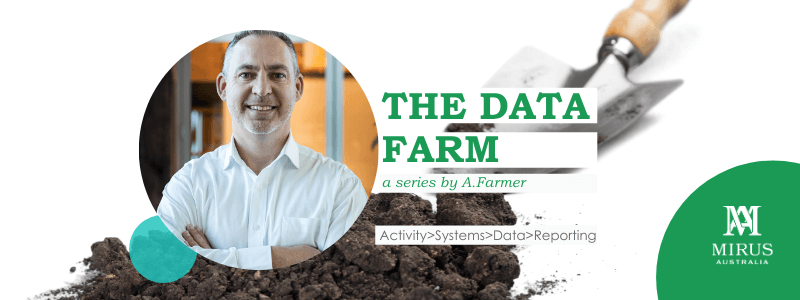The Data Farm Series with A Farmer: Activities > Systems > Data > Reporting
April 8, 2020 | Aged Care Management

I have been fascinated by the interest, impact and importance of data. Around the world.
There is a recognised cliché in scientific circles which says “In God we trust, others must provide data.” Our world’s governments and organisations such as the World Health Organisation have been desperate to gather data, analyse and model it in the hope of finding answers or at least to support their decision making and preferably in real-time.
Locally, it’s hard to believe that the ITAC2020 aged care conference was only a month ago.
The fact that we were all together with our colleagues and clients, in another state other that our home states at the beginning of March – well it seems crazy now!
Our message at the ITAC 2020 conference and Mirus Australia for this past year was “change doesn’t have to suck.”
As it turns out this was quite a prophetic message.
Although our collective goal was to address the amount of change going on in Aged Care, it has been completely overwhelmed now by the change impacting the entire world.
(Historians may one day argue that no one alive today has ever been through this much change)
At the ITAC2020 conference, I gave a presentation on the importance of data in Aged Care.
In The Data Farm Series I will provide further insights from the presentation I gave.
I am not a data expert but I can provide further insights that occupy our more intense debates at Mirus!
We are a company who prides itself on an innovation mindset and a track record of helping our clients with data, insight and systems – since 2010.
I will share a model about how we extract data and insight out of a revenue, admissions and workforce management systems.
This is a simple concept that can unlock many of the misunderstandings about why it is so difficult to get the answers we need form the systems we have or are trying to implement.
The concept is this:
Activities go into systems. Systems capture data. Data creates reporting.
This can be expressed as a pyramid or a process. I like the pyramid because it adds a scale dimension and helps to creates a simple narrative. One of the explicit (or implicit) expectations for every system implementation is the ability to get information (data/insight) out of that system on what the business is doing (activities). A common mistake is the assumption that we can go from activities to reporting in one step! (Are the IT professionals nodding right now?).
That of course is the ultimate goal but all of these steps are important in the following ways.
(1) Activities – every business has many activities, some of these will be put into or supported by the system.
(2) Systems – will need to reflect the activities and also capture the data required.
(3) Data – needs to be in a specific architecture that defines it well enough to allow it to create the reporting.
(4) Reporting – will need to be defined for those activities the business needs insight on.
OR Activities > Systems > Data > Reporting.
Always start with the end in mind and design your reporting first, then work backwards to ensure the ambiguities are removed, the data is captured in the system and the current process and activities will support the use of the system to achieve that outcome.
Maybe this seems simplistic or obvious, but I have spent countless hours in my career explaining this one concept.
In my experience, this is best place to start.
Change may suck, so we’re not going anywhere. To find out how we can make a difference please contact us here.
Follow Andrew Farmer, Chief Executive Officer Mirus Australia on LinkedIn who is an expert in managing transformation and technology projects in Australia and Internationally for the past 20 years.


